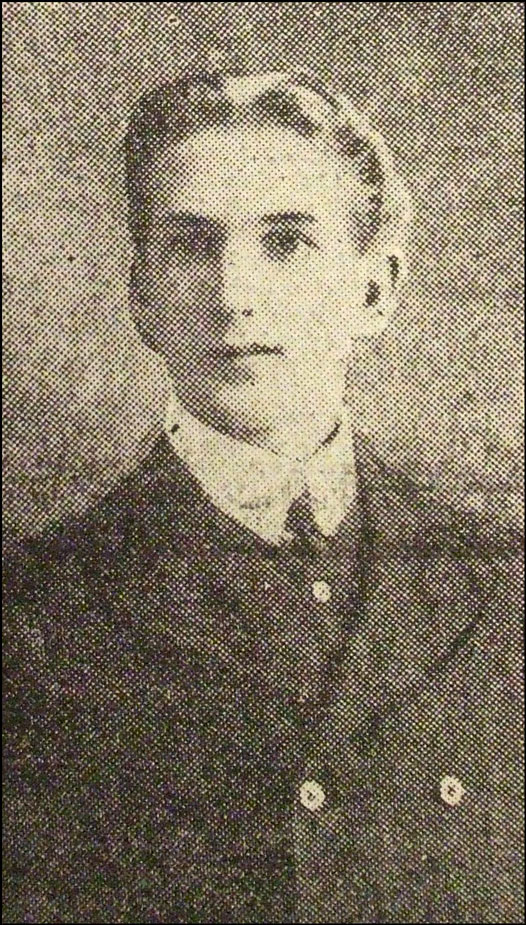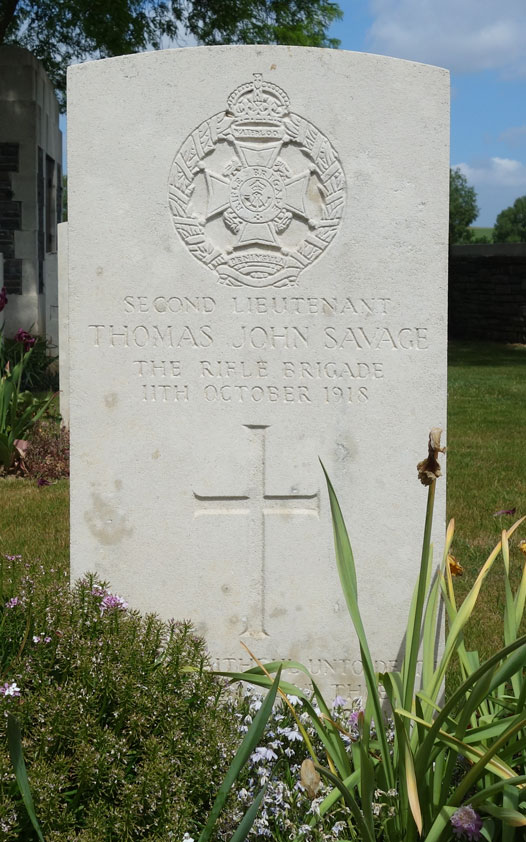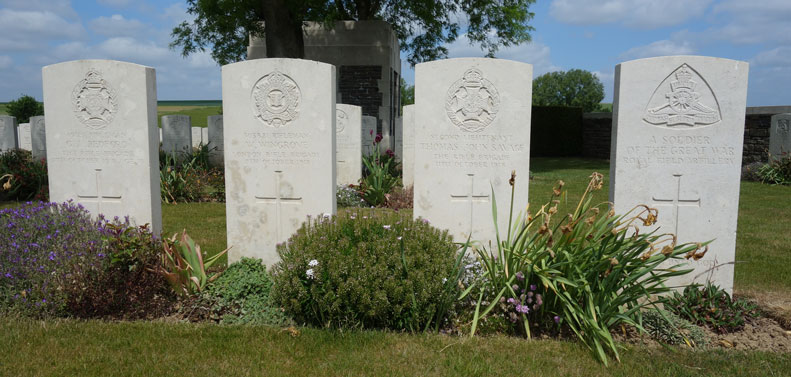![]() In memoriam
In memoriam ![]()
Second Lieutenant Thomas John Savage


Thomas John Savage was born on 18 April 1885 at Pound Street, Larne, County Antrim, the first of two children of shoemaker Robert Savage and his wife Martha (nee Cobain). Following the death of his mother in 1896, Thomas and his younger sister Elizabeth (or Ismay) were brought up at Larne by his maternal grandmother and two aunts.
Savage was educated at the Larne Model Agricultural National School. Between 1904 and 1908 he served in the North of Ireland Imperial Yeomanry, leaving when his period of service expired. On the outbreak of war he was working as a clerk in the Larne office of Belfast solicitors Messrs. Moorhead & Wood.
Savage enlisted in the North Irish Horse at Belfast on 13 August 1914 (No.999 – later Corps of Hussars No.71191), and a week later embarked for France with C Squadron, seeing action in the retreat from Mons and advance to the Aisne.
Two letters written by Savage were published in the Larne Times and Weekly Advertiser on 19 September 1914:
Mr. Tom Savage, Larne, who is an old member of the North Irish Horse, and is now at the front, has written a couple of interesting letters to relatives at Larne. The first letter was received at the beginning of the month, and the writer deals light-heartedly with his journey and the prospect in front of him. His many friends in the town will join in wishing Tom all sorts of good luck and a safe return.
No. 2 Troop.
At Sea.
Just a line to let you know that we are landing outside [Le Havre]. They kept us without any knowledge of how and where we were going till the last moment. I am quite well and extra specially fit. It is good fun on a troopship, and we are going to have a nice little holiday on the Continent. I'll be able to "swank French" when I come back. I'll write a good long letter when I settle down. I'm writing this at tea time just before we land. [Le Havre], from the ship, seems to be a very pretty place. I have got two very nice chums, Jack Wright, the footballer, who has seen service before, and Billy Caughey, both of Belfast.(Letter No. 2.)
I am writing this note while on outpost duty. I can't say where we are, or anything like that, but I am in the best of health and enjoying the life. ... I have sent you another letter and p.c., but I don't know whether they will all be delivered. I am getting a fine hand at French. ... There is plenty of food and the people are all very nice. It's great fun trying to understand them. Plenty of fruit here, pears and apples galore, and as for bread big long rolls and rings of it, and all very cheap. When you happen to be riding through a town the people give you cigarettes, fruit, chocolates, and cider. ... If you are all extra good I'll bring you home a pet German. How is Home Rule getting on? Send me a paper, but I don't know when I'll get it or you'll get this. I suppose the papers are full of this ruction. I can write no more as I'll soon have to go on guard.
Savage was promoted to trumpeter on 4 November 1914 and lance corporal on 9 January 1915. The following March he returned home on leave. The Larne Times reported:
A welcome week-end visitor to his home was Trooper Tom Savage, of the North Irish Horse, who has been at the front for some months. Trooper Savage looked in the pink of condition, and, indeed, appeared to have put on weight since his departure from Larne. His troop is at present engaged in reconnaissance work somewhere in the direction of Ypres, and, taking all hardships as part of the day's work, are in the best of spirits. Tom received scores of the warmest greetings, and all our good wishes go with him back to the front.
Savage was promoted to corporal on 24 November 1915, and sergeant on 4 March 1917. On 10 June 1916 he was severely reprimanded for leaving the ranks without permission the previous day.
In June 1916 C Squadron of the North Irish Horse came together with F Squadron and the 6th (Inniskilling) Dragoons Service Squadron to form the 2nd North Irish Horse Regiment, serving as corps cavalry to X Corps until September 1917, when the regiment was dismounted and most of its men were transferred to the infantry. Savage, however had applied for a commission in the infantry or Royal Flying Corps at the end of August. He left France a month later and following a period of leave, on 16 November 1917 reported for duty at the No.7 Officer Cadet Battalion at Fermoy. After a period of training he was assessed as having good education, military knowledge and powers of command and leadership, together with the ability to ride and knowledge of the Hotchkiss machine gun. As such, he "should make a good Platoon commander".
On 27 March 1918 Savage was commissioned as a 2nd lieutenant and posted to the Rifle Brigade. He joined the 3rd Battalion at the front in the Loos sector on 4 August.
Savage saw action with his battalion during the Advance to Victory offensive. On 10 October they were ordered to take St Aubert the next day. According to the battalion war diary:
... the assembly was carried out and the Attack was commenced according to plan, with the exception that the actual start was about 5 mins. late. As, however, no concerted attack with troops on our right had been arranged, and as Battn. on our left did not start until a great deal later, this did not make any difference. On emerging from Avesnes[-les-Aubert], the leading Coys came under heavy artillery and M.G. fire, but advancing, they reached the houses to the west of St. Aubert, where hand to hand fighting took place. By this time they were suffering very severe casualties from Machine Guns on the flanks, and they were forced to withdraw slightly and take up a line from the sunken road in U.23.b to railway U.24.c. Here they held on all day under most trying circumstances, with noone on the flanks, and being shot at by observed M.G. and artillery fire. ... At the start, no artillery assistance was available, and very little could be done to help the two leading Coys.
Casualties for the day were two officers and 48 other ranks killed, seven officers and 126 other ranks wounded, three other ranks missing and two believed prisoners. During the night the enemy withdrew and St Aubert was taken without opposition.
Second Lieutenant Savage was one of the officers who lost his life that day. The Larne Times later reported that:
... a brother-officer says he was "shot through the heart by a German machine-gun, and died instantaneously whilst leading his platoon with great gallantry against a village then in German hands. He made a splendid advance, and was less than 300 yards from the foe when he fell. We are all proud of him." His commanding officer wrote:– "His loss to the battalion is a very real one, as, although he had not been with us very long, we had all learned to recognise his abilities and his aptitude for his work."
Savage was buried in the St Aubert British Cemetery, Nord, France, grave I.A.36. His gravestone inscription reads:
SECOND LIEUTENANT
THOMAS JOHN SAVAGE
THE RIFLE BRIGADE
11TH OCTOBER 1918
BE THOU FAITHFUL UNTO DEATH
AND I WILL GIVE THEE
A CROWN OF LIFE
REV.2.10

Gravestone images Copyright © Phillip Tardif with all rights reserved as set out in this Use of Material policy. Image of Thomas Savage from the Belfast Evening Telegraph, kindly provided by Nigel Henderson, Researcher at History Hub Ulster (www.greatwarbelfastclippings.com).
